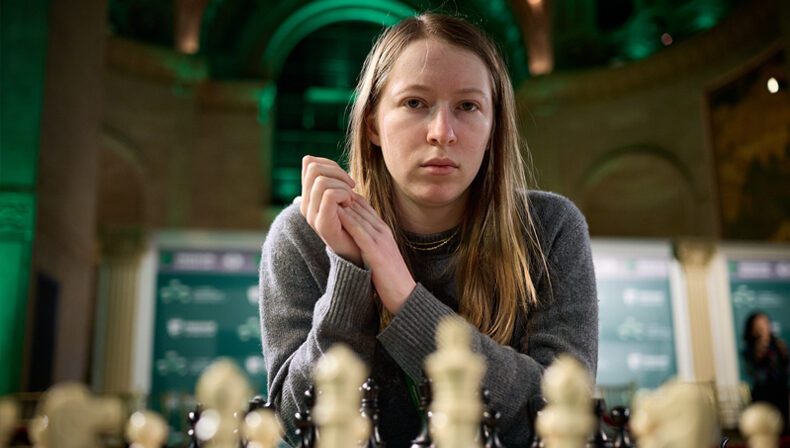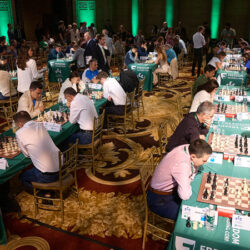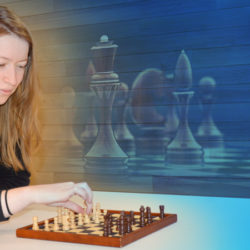
High level chess players spend significant time studying opening theory, endgame theory, and core strategic principles under a consistent rule set.
An exciting way to change the game is by playing with variants, which are alterations to standard chess rules. Variants intentionally shake up existing patterns, reducing the value of memorization and instead rewarding players’ intuition.
Enter a brand-new variant I created: the Susquehanna Swap.
The Susquehanna Swap Variant
The Susquehanna Swap variant is very close to standard chess, but it gives players a few more options on any given move.
On a player’s move, they can swap the locations of one of their bishops and one of their knights instead of making a standard move. They also have a one-time use ability to swap the location of one of their rooks with one of their bishops or knights (again in place of a standard move).
When should a player exercise the one-time-use swap ability?
With the Susquehanna Swap, one of the initial decisions a player faces is determining the right time to exercise the one-time-use ability.
It can be an error to exercise the ability too early, when better opportunities are likely to arise.
However, it can also be risky to allow the game to progress and resort to using the power as defense out of necessity, rather than as a tool to intensify an attack. (Or worse, lose the ability entirely if rooks get traded away.)
This decision has some properties of an optimal stopping problem: a player must assess how the opportunity available compares to the set of possible future opportunities.
What are the immediate impacts of the Susquehanna Swap on the chess game?
The variant has the greatest impact on the relative values of bishops and knights. While bishops and knights are typically regarded as comparable pieces in terms of point value, the variant comparatively increases the value of bishops more. Suddenly, a light square bishop has the ability to become a dark square bishop by swapping locations with a knight. While bishops gain the ability to traverse the (previously inaccessible) other 50% of the board, knights similarly gain long-range ability. One primary handicap of knights in standard chess is their inability to move across the board quickly, but now a knight can remain involved in two simultaneously unfolding scenarios.
How does this variant impact different styles of play?
There are two primary styles of chess play – tactical and positional.
Tactical play is typically relevant in more complex positions with lots of piece activity where players look to set up sequences of forcing moves that result in material gain. This play style requires strong calculation skill (seeing far down a decision tree) and is commonly associated with [computer] engine play.
Positional play is more focused on long term tradeoffs. It often shows up in positions where the number of viable move options is very large (typically those where it is difficult to determine the immediate advantages or disadvantages of any given move.)
With swapping introduced, piece preservation decisions start to become a major component of positional play. In tactically sharp positions, the swap greatly increases the complexity – it essentially is multiplying the option space. At each node of your mental decision tree, you have to factor in another decision that you or your opponent could take. And that decision vastly increases the possibility space for the next decision.
The way the swap affects decisions is highly dependent on the way the game is progressing and the phase of the game.
Which parts of the game become more complex due to the swap?
The swap adds the most complexity to the middlegame because of the decision tree growth. It also has a significant impact on endgame play if the appropriate pairs of pieces remain on the board.
What are some interesting hypothetical scenarios that arise from swapping pieces?
Some unusual situations can arise: rooks can activate much more quickly; bishops of the same color can exist; pawns promoting will more often become rooks, bishops, and knights to regain swapping ability.
Pieces are also slightly more difficult to trap – restricting a piece’s set of escape options is no longer sufficient to trap the piece. For example, a knight in the corner is often easily trapped, but a bishop in the corner is perfectly fine. So, a player may elect to swap a knight in the corner with a bishop as a means of saving the knight.
How does this affect trade evaluation?
It is valuable to hold onto at least one bishop, one knight and—while the one-time swap is available—one rook. Preserving the pieces of the game that enable players to use the swapping ability becomes a major consideration when pieces are getting traded.
Players can try to force their opponent into trades that will reduce or remove their swapping ability. Players may also compel their opponents to use the one-time swap in suboptimal ways by threatening to trade off the rooks.
We can also at times see seemingly imbalanced positions where one player has a material advantage, but win probability may be close to 50-50 if the player with the material disadvantage still has the one-time-use swap ability. A mapping between material “points” and swap opportunity value emerges, which can lead to initially counterintuitive sacrifices and trades.
Takeaways
Variants exist on a spectrum from “close relative of chess” (960, duck chess) to “entirely different species” (three check, king of the hill, losers chess). Others introduce the element of team coordination (bughouse, hand & brain).
In general, the best variants have a few common properties
- They are not easily solvable. If optimal strategy can be determined quickly, the game is not going to be very interesting.
- They do not create a massive advantage for one side. For example, a variant that allows a player to move 3 times in a row would likely create a large advantage for white.
- They handle edge cases neatly. Rule alterations can often lead to complications involving the precise definitions of rules, requiring a rule-hierarchy to be defined. (See Nepo vs So 960 castling)
- They should illuminate some quality of chess or unlock a new strategic wrinkle. For example, duck chess adds an additional layer to the concepts of tempo and triangulation.
Susquehanna Swap is among the less extreme variants, but it has all of the properties listed above. It retains most of the features of standard chess, but rewards creative, resourceful, and opportunistic play. I’ve explored a variety of hypothetical rule changes, with varying degrees of deviation from standard chess:
- On a player’s turn, instead of moving a piece, they have the option to remove one of their own pieces. Capturing one’s own pieces is also legal.
- Pawns have the ability to move one or two squares forward for the whole game. Capturing remains normal.
- Players have a one-time-use ability to move twice in a row. Intermediate move cannot result in check or involve capturing.
- Pawns can promote into another piece when they reach the 6th / 3rd rank.
If you’re looking to add a new variant into your rotation, feel free to try one of these ideas or give Susquehanna Swap a shot!




Subscribe Now
Get each new post sent straight to your inbox